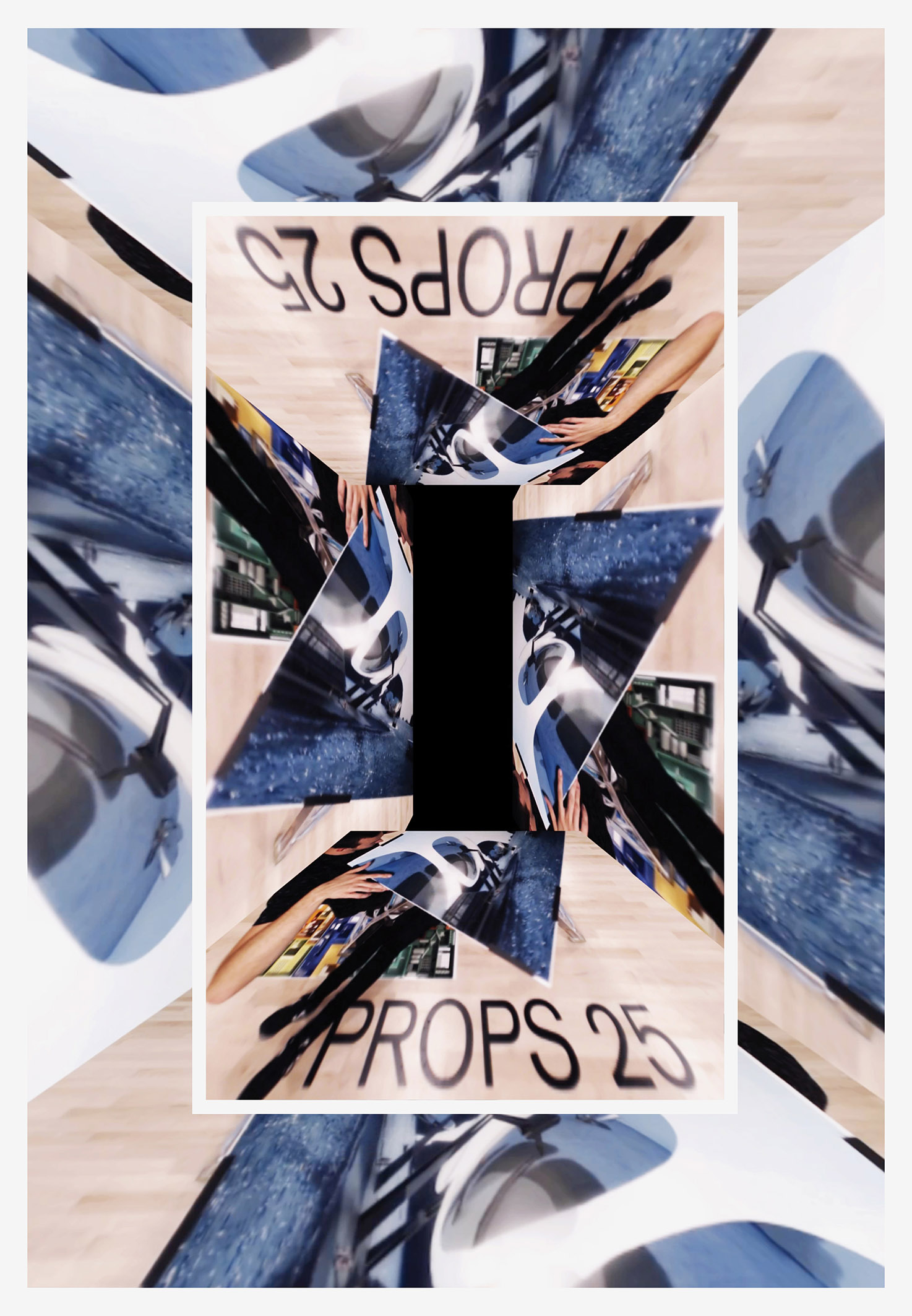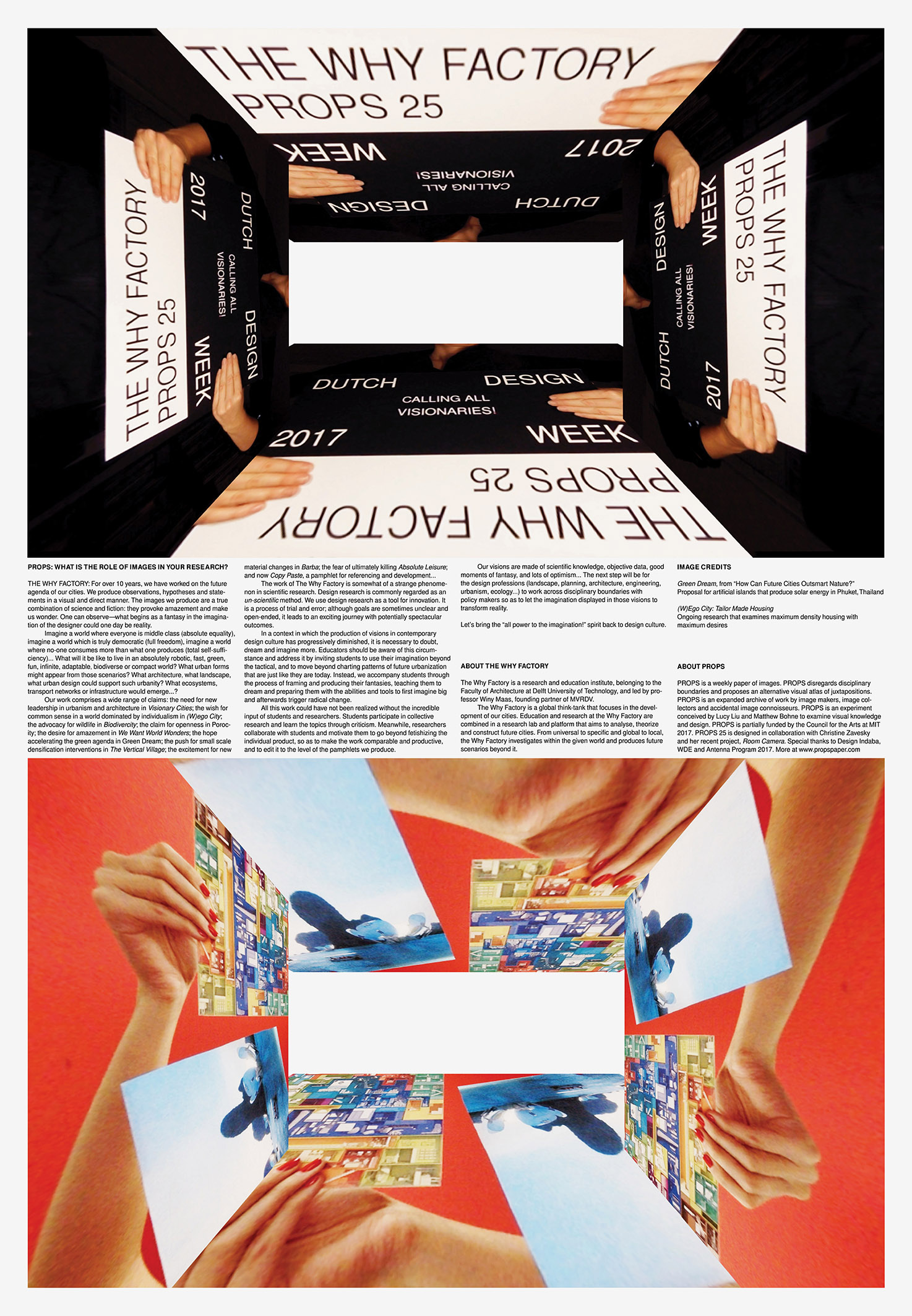

25 CALLING ALL VISIONARIES
THE WHY FACTORY︎︎︎
For over 10 years, we have worked on the future agenda of our cities. We produce observations, hypotheses and statements in a visual and direct manner. The images we produce are a true combination of science and fiction: they provoke amazement and make us wonder. One can observe — what begins as a fantasy in the imagination of the designer could one day be reality.
Imagine a world where everyone is middle class (absolute equality), imagine a world which is truly democratic (full freedom), imagine a world where no-one consumes more than what one produces (total self-sufficiency) … What will it be like to live in an absolutely robotic, fast, green, fun, infinite, adaptable, biodiverse or compact world? What urban forms might appear from those scenarios? What architecture, what landscape, what urban design could support such urbanity? What ecosystems, transport networks or infrastructure would emerge…?
Our work comprises a wide range of claims: the need for new leadership in urbanism and architecture in Visionary Cities; the wish for common sense in a world dominated by individualism in![]() ; the advocacy for wildlife in Biodivercity ; the claim for openness in Porocity ; the desire for amazement in We Want World Wonders ; the hope accelerating the green agenda in
; the advocacy for wildlife in Biodivercity ; the claim for openness in Porocity ; the desire for amazement in We Want World Wonders ; the hope accelerating the green agenda in ![]() ; the push for small scale densification interventions in The Vertical Village ; the excitement for new material changes in Barba ; the fear of ultimately killing Absolute Leisure ; and now Copy Paste, a pamphlet for referencing and development…
; the push for small scale densification interventions in The Vertical Village ; the excitement for new material changes in Barba ; the fear of ultimately killing Absolute Leisure ; and now Copy Paste, a pamphlet for referencing and development…
The work of The Why Factory is somewhat of a strange phenomenon in scientific research. Design research is commonly regarded as an un-scientific method. We use design research as a tool for innovation. It is a process of trial and error; although goals are sometimes unclear and open-ended, it leads to an exciting journey with potentially spectacular outcomes.
In a context in which the production of visions in contemporary design culture has progressively diminished, it is necessary to doubt, dream and imagine more. Educators should be aware of this circumstance and address it by inviting students to use their imagination beyond the tactical, and to move beyond charting patterns of future urbanization that are just like they are today. Instead, we accompany students through the process of framing and producing their fantasies, teaching them to dream and preparing them with the abilities and tools to first imagine big and afterwards trigger radical change.
All this work could have not been realized without the incredible input of students and researchers. Students participate in a collective research and learn the topics through criticism. Meanwhile, researchers collaborate with students and motivate them to go beyond fetishizing the individual product, so as to make the work comparable and productive, and to edit it to the level of the pamphlets we produce.
Our visions are made of scientific knowledge, objective data, good moments of fantasy, and lots of optimism… The next step will be for the design professions (landscape, planning, architecture, engineering, urbanism, ecology...) to work across disciplinary boundaries with policy makers so as to let the imagination displayed in those visions to transform reality.
Let’s bring the “all power to the imagination!” spirit back to design culture.
Images
(W)Ego City: Tailor Made Housing
Ongoing research that examines maximum density housing with maximum desires
Green Dream, From “How Future Cities Can Outsmart Nature?"
Proposal for artificial islands that produce solar energy in Phuket, Thailand
THE WHY FACTORY︎︎︎ is a research and education institute, belonging to the Faculty of Architecture at Delft University of Technology, and led by professor Winy Maas, founding partner of MVRDV. The Why Factory is a global think-tank that focuses in the development of our cities. Education and research at the Why Factory are combined in a research lab and platform that aims to analyse, theorize and construct future cities. From universal to specific and global to local, the Why Factory investigates within the given world and produces future scenarios beyond it.
PROPS PAPER 25 is commissioned by Design Indaba, WDE and Antenna Program 2017. The issue was designed in collaboration with Christine Zavesky and her project, Room Camera.
For over 10 years, we have worked on the future agenda of our cities. We produce observations, hypotheses and statements in a visual and direct manner. The images we produce are a true combination of science and fiction: they provoke amazement and make us wonder. One can observe — what begins as a fantasy in the imagination of the designer could one day be reality.
Imagine a world where everyone is middle class (absolute equality), imagine a world which is truly democratic (full freedom), imagine a world where no-one consumes more than what one produces (total self-sufficiency) … What will it be like to live in an absolutely robotic, fast, green, fun, infinite, adaptable, biodiverse or compact world? What urban forms might appear from those scenarios? What architecture, what landscape, what urban design could support such urbanity? What ecosystems, transport networks or infrastructure would emerge…?
Our work comprises a wide range of claims: the need for new leadership in urbanism and architecture in Visionary Cities; the wish for common sense in a world dominated by individualism in
(W)ego City

Green Dream

The work of The Why Factory is somewhat of a strange phenomenon in scientific research. Design research is commonly regarded as an un-scientific method. We use design research as a tool for innovation. It is a process of trial and error; although goals are sometimes unclear and open-ended, it leads to an exciting journey with potentially spectacular outcomes.
In a context in which the production of visions in contemporary design culture has progressively diminished, it is necessary to doubt, dream and imagine more. Educators should be aware of this circumstance and address it by inviting students to use their imagination beyond the tactical, and to move beyond charting patterns of future urbanization that are just like they are today. Instead, we accompany students through the process of framing and producing their fantasies, teaching them to dream and preparing them with the abilities and tools to first imagine big and afterwards trigger radical change.
All this work could have not been realized without the incredible input of students and researchers. Students participate in a collective research and learn the topics through criticism. Meanwhile, researchers collaborate with students and motivate them to go beyond fetishizing the individual product, so as to make the work comparable and productive, and to edit it to the level of the pamphlets we produce.
Our visions are made of scientific knowledge, objective data, good moments of fantasy, and lots of optimism… The next step will be for the design professions (landscape, planning, architecture, engineering, urbanism, ecology...) to work across disciplinary boundaries with policy makers so as to let the imagination displayed in those visions to transform reality.
Let’s bring the “all power to the imagination!” spirit back to design culture.
Images
(W)Ego City: Tailor Made Housing
Ongoing research that examines maximum density housing with maximum desires
Green Dream, From “How Future Cities Can Outsmart Nature?"
Proposal for artificial islands that produce solar energy in Phuket, Thailand
THE WHY FACTORY︎︎︎ is a research and education institute, belonging to the Faculty of Architecture at Delft University of Technology, and led by professor Winy Maas, founding partner of MVRDV. The Why Factory is a global think-tank that focuses in the development of our cities. Education and research at the Why Factory are combined in a research lab and platform that aims to analyse, theorize and construct future cities. From universal to specific and global to local, the Why Factory investigates within the given world and produces future scenarios beyond it.
PROPS PAPER 25 is commissioned by Design Indaba, WDE and Antenna Program 2017. The issue was designed in collaboration with Christine Zavesky and her project, Room Camera.